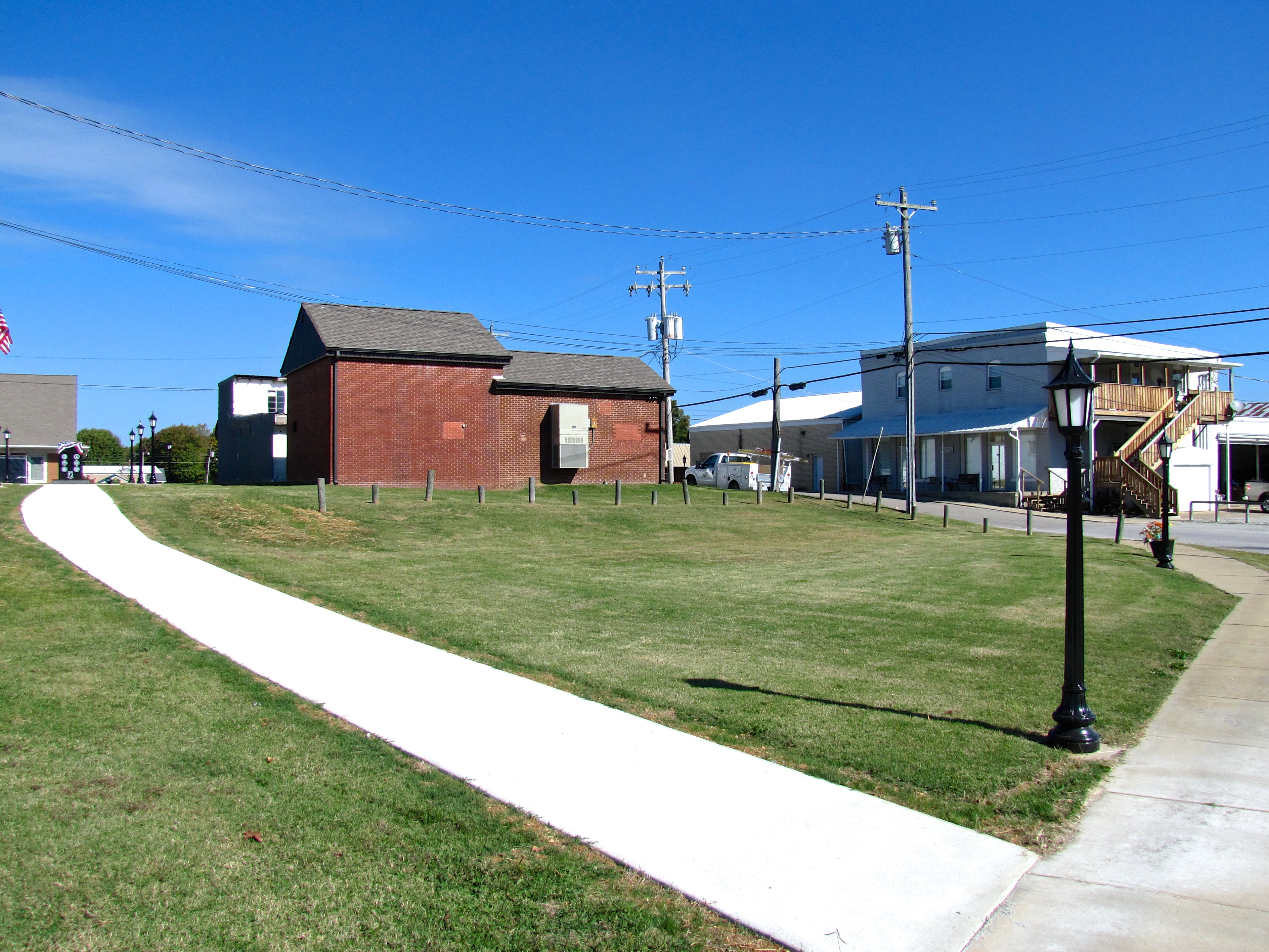|
Iron City, Tennessee
Iron City is a census-designated place and former city in Lawrence and Wayne Counties, Tennessee. Iron City was incorporated as a city from 1887 to 1901, and again from 1962 until 2010, its residents voting to disincorporate in the last year.Larry Miller, Tennessee Place Names' (Indiana University Press, 2001), 107. The United States Census treated the community as a census-designated place for both the 2010 and 2020 censuses. It had a population of 328 in 2010 and 274 in 2020. History Iron City gets its name from an iron foundry that operated in its vicinity in the late 19th century. While iron ore was mined in southwestern Lawrence County as early as the 1830s, the industry really began to thrive in 1886, when a branch railroad line to the area was completed. Iron City incorporated the following year. At its height, Iron City supported a population of about 1000 and included two hotels and two banks. Geography Iron City is situated in the Shoal Creek Valley, north of th ... [...More Info...] [...Related Items...] OR: [Wikipedia] [Google] [Baidu] |
Census-designated Place
A census-designated place (CDP) is a Place (United States Census Bureau), concentration of population defined by the United States Census Bureau for statistical purposes only. CDPs have been used in each decennial census since 1980 as the counterparts of incorporated places, such as self-governing city (United States), cities, town (United States), towns, and village (United States), villages, for the purposes of gathering and correlating statistical data. CDPs are populated areas that generally include one officially designated but currently unincorporated area, unincorporated community, for which the CDP is named, plus surrounding inhabited countryside of varying dimensions and, occasionally, other, smaller unincorporated communities as well. CDPs include small rural communities, Edge city, edge cities, colonia (United States), colonias located along the Mexico–United States border, and unincorporated resort and retirement community, retirement communities and their environs. ... [...More Info...] [...Related Items...] OR: [Wikipedia] [Google] [Baidu] |
Iron Ore
Iron ores are rocks and minerals from which metallic iron can be economically extracted. The ores are usually rich in iron oxides and vary in color from dark grey, bright yellow, or deep purple to rusty red. The iron is usually found in the form of magnetite (, 72.4% Fe), hematite (, 69.9% Fe), goethite (, 62.9% Fe), limonite (, 55% Fe), or siderite (, 48.2% Fe). Ores containing very high quantities of hematite or magnetite (typically greater than about 60% iron) are known as natural ore or irect shipping ore and can be fed directly into iron-making blast furnaces. Iron ore is the raw material used to make pig iron, which is one of the main raw materials to make steel — 98% of the mined iron ore is used to make steel. In 2011 the ''Financial Times'' quoted Christopher LaFemina, mining analyst at Barclays Capital, saying that iron ore is "more integral to the global economy than any other commodity, except perhaps oil". Sources Elemental iron is virtually absent o ... [...More Info...] [...Related Items...] OR: [Wikipedia] [Google] [Baidu] |
Poverty Line
The poverty threshold, poverty limit, poverty line, or breadline is the minimum level of income deemed adequate in a particular country. The poverty line is usually calculated by estimating the total cost of one year's worth of necessities for the average adult.Poverty Lines – Martin Ravallion, in The New Palgrave Dictionary of Economics, 2nd Edition, London: Palgrave Macmillan The cost of housing, such as the renting, rent for an apartment, usually makes up the largest proportion of this estimate, so economists track the real estate market and other housing cost indicators as a major influence on the poverty line. Individual factors are often used to account for various circumstances, such as whether one is a parent, elderly, a child, married, etc. The poverty threshold may be adjusted annually. In practice, like the definition of poverty, the official or common understanding of the poverty line is significantly higher in developed country, developed countries than in developi ... [...More Info...] [...Related Items...] OR: [Wikipedia] [Google] [Baidu] |
Per Capita Income
Per capita income (PCI) or average income measures the average income earned per person in a given area (city, region, country, etc.) in a specified year. In many countries, per capita income is determined using regular population surveys, such as the American Community Survey. This allows the calculation of per capita income for both the country as a whole and specific regions or demographic groups. However, comparing per capita income across different countries is often difficult, since methodologies, definitions and data quality can vary greatly. Since the 1990s, the OECD has conducted regular surveys among its 38 member countries using a standardized methodology and set of questions. Per capita income is often used to measure a sector's average income and compare the wealth of different populations. Per capita income is also often used to measure a country's standard of living. When used to compare income levels of different countries, it is usually expressed using a commonly ... [...More Info...] [...Related Items...] OR: [Wikipedia] [Google] [Baidu] |
Census
A census (from Latin ''censere'', 'to assess') is the procedure of systematically acquiring, recording, and calculating population information about the members of a given Statistical population, population, usually displayed in the form of statistics. This term is used mostly in connection with Population and housing censuses by country, national population and housing censuses; other common censuses include Census of agriculture, censuses of agriculture, traditional culture, business, supplies, and traffic censuses. The United Nations (UN) defines the essential features of population and housing censuses as "individual enumeration, universality within a defined territory, simultaneity and defined periodicity", and recommends that population censuses be taken at least every ten years. UN recommendations also cover census topics to be collected, official definitions, classifications, and other useful information to coordinate international practices. The United Nations, UN's Food ... [...More Info...] [...Related Items...] OR: [Wikipedia] [Google] [Baidu] |
Lauderdale County, Alabama
Lauderdale County is a county located in the northwestern corner of the U.S. state of Alabama. At the 2020 census the population was 93,564. Its county seat is Florence. Its name is in honor of Colonel James Lauderdale, of Tennessee. Lauderdale is part of the Florence-Muscle Shoals, AL Metropolitan Statistical Area, also known as " The Shoals". History Lauderdale County was named in honor of Col. James Lauderdale who was born in Virginia in about 1780. In the early 19th century, Lauderdale, who moved to West Tennessee, became a major in General John Coffee's cavalry of volunteers. Later promoted to lieutenant colonel, he commanded a brigade of mounted riflemen, serving under Andrew Jackson. According to reliable historians, Col. Lauderdale did not die in the Battle of New Orleans, but was wounded in the Battle of Talladega and died on December 23, 1814, seventeen days before Jackson's decisive defeat of the British at New Orleans. Several towns and counties in the southern sta ... [...More Info...] [...Related Items...] OR: [Wikipedia] [Google] [Baidu] |
Lawrenceburg, Tennessee
The city of Lawrenceburg is the county seat of Lawrence County, Tennessee, United States, The largest city on the state's southern border between Chattanooga and Memphis, it lies on the banks of Shoal Creek. The population was 11,633 at the 2020 United States Census. The city is named after War of 1812 American Navy officer James Lawrence. Located around southwest of Nashville at the junction of U.S. Routes 43 and 64, Lawrenceburg is called the "Crossroads of Dixie." History According to a recent theory, the Lawrenceburg area is the likely site of " Chicasa"—the place where Spanish explorer Hernando de Soto and his men wintered in 1540–41 (though earlier theories have suggested this campsite to have been in northern Mississippi). The Chickasaw Nation sold the area to the US in 1816. Upon moving from East Tennessee into the region around 1817, David Crockett served as a justice of the peace, a colonel of the militia, and a state representative. David Crockett establ ... [...More Info...] [...Related Items...] OR: [Wikipedia] [Google] [Baidu] |
Westpoint, Tennessee
Westpoint (also West Point) is an unincorporated community in Lawrence County, Tennessee Tennessee (, ), officially the State of Tennessee, is a landlocked U.S. state, state in the Southeastern United States, Southeastern region of the United States. It borders Kentucky to the north, Virginia to the northeast, North Carolina t ..., United States. Its ZIP code is 38486. Demographics Notes Unincorporated communities in Lawrence County, Tennessee Unincorporated communities in Tennessee {{LawrenceCountyTN-geo-stub ... [...More Info...] [...Related Items...] OR: [Wikipedia] [Google] [Baidu] |
Tennessee State Route 242
State Route 242 (SR 242) is a north-south state highway that lies mostly in Lawrence County, Tennessee, United States. It connects Iron City with Henryville via Westpoint and Lawrenceburg. Route description SR 242 begins in Lawrence County in Iron City at an intersection with SR 227. It heads north as Wayland Springs Road to temporarily cross into Wayne County before returning to Lawrence County and leaving Iron City to wind its way northeast through mountains, running parallel to Shoal Creek. It then crosses over Factory Creek to pass through Westpoint before winding its way through some more mountains as West Point Road. The highway then enters farmland shortly before entering Lawrenceburg at an interchange with US 64/ SR 15. SR 242 turns northward to pass through some neighborhoods before coming to an intersection and becoming concurrent with US 64 Business (W Gaines Street). They head east along the southern end of David Crockett State Park before crossing Shoa ... [...More Info...] [...Related Items...] OR: [Wikipedia] [Google] [Baidu] |
Collinwood, Tennessee
Collinwood is a city in Wayne County, Tennessee, Wayne County, Tennessee, United States. The population was 982 at the 2010 United States Census, 2010 census, down from 1,024 in 2000. History Collinwood was established in 1913 as a stop on the Tennessee Western Railroad, a rail line constructed to serve the area iron industry. The city was named for W.W. Collins, president of the Collinwood Land Company, which platted the city. While the railroad, which intersected the Louisville and Nashville Railroad, L&N system at Iron City, Tennessee, Iron City, was originally to extend northward to Hohenwald, Tennessee, Hohenwald, plans for extension beyond Collinwood never materialized, and the city became the railroad's western terminus.Richard Quin and Miranda RocheNational Register of Historic Places Inventory Form for Collinwood Railroad Station September 1987, Sec. 8, pp. 1-4. The Collinwood Land Company advertised lots for the new city in June 1913, and by the following year, abou ... [...More Info...] [...Related Items...] OR: [Wikipedia] [Google] [Baidu] |




